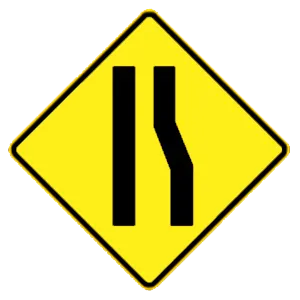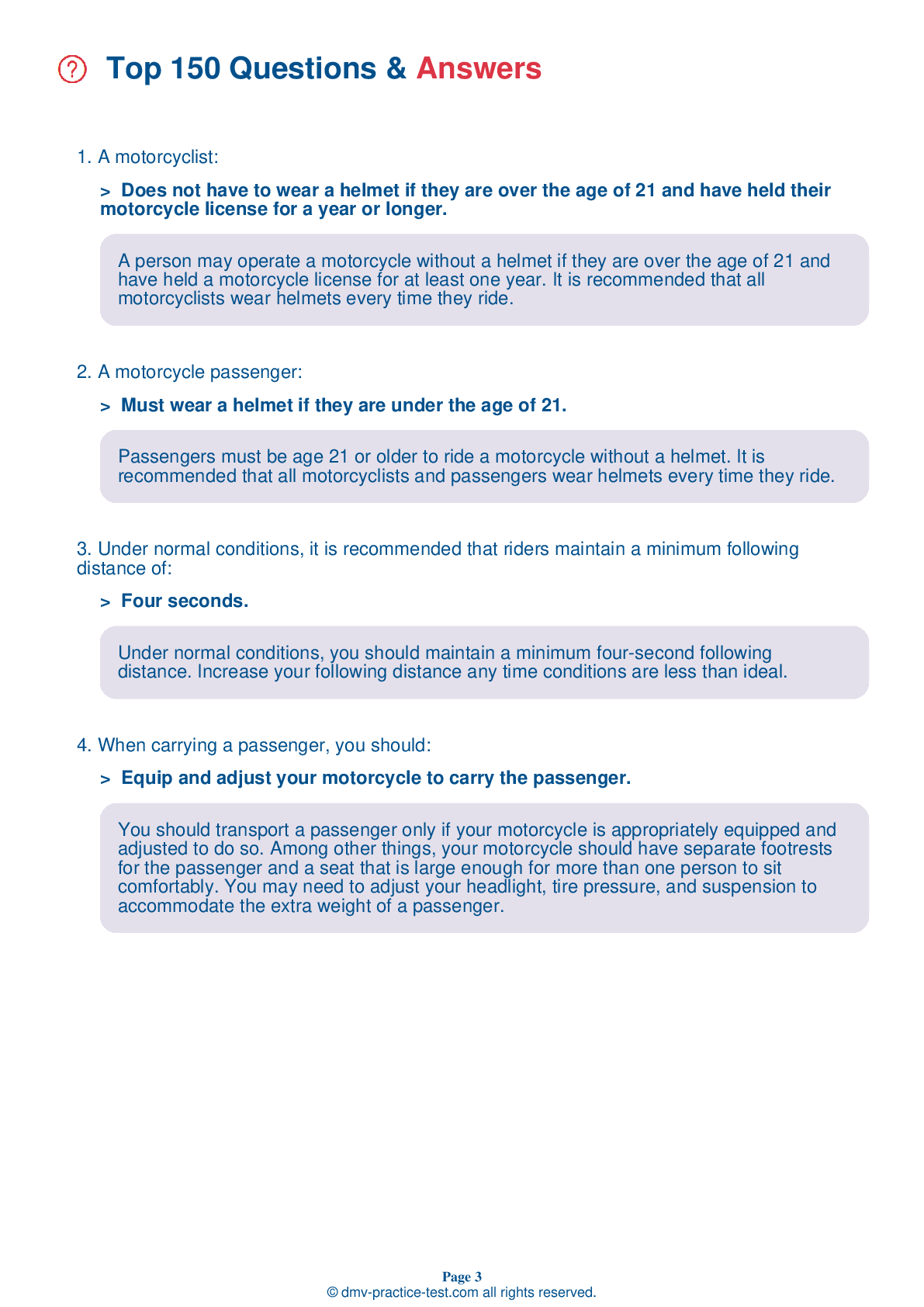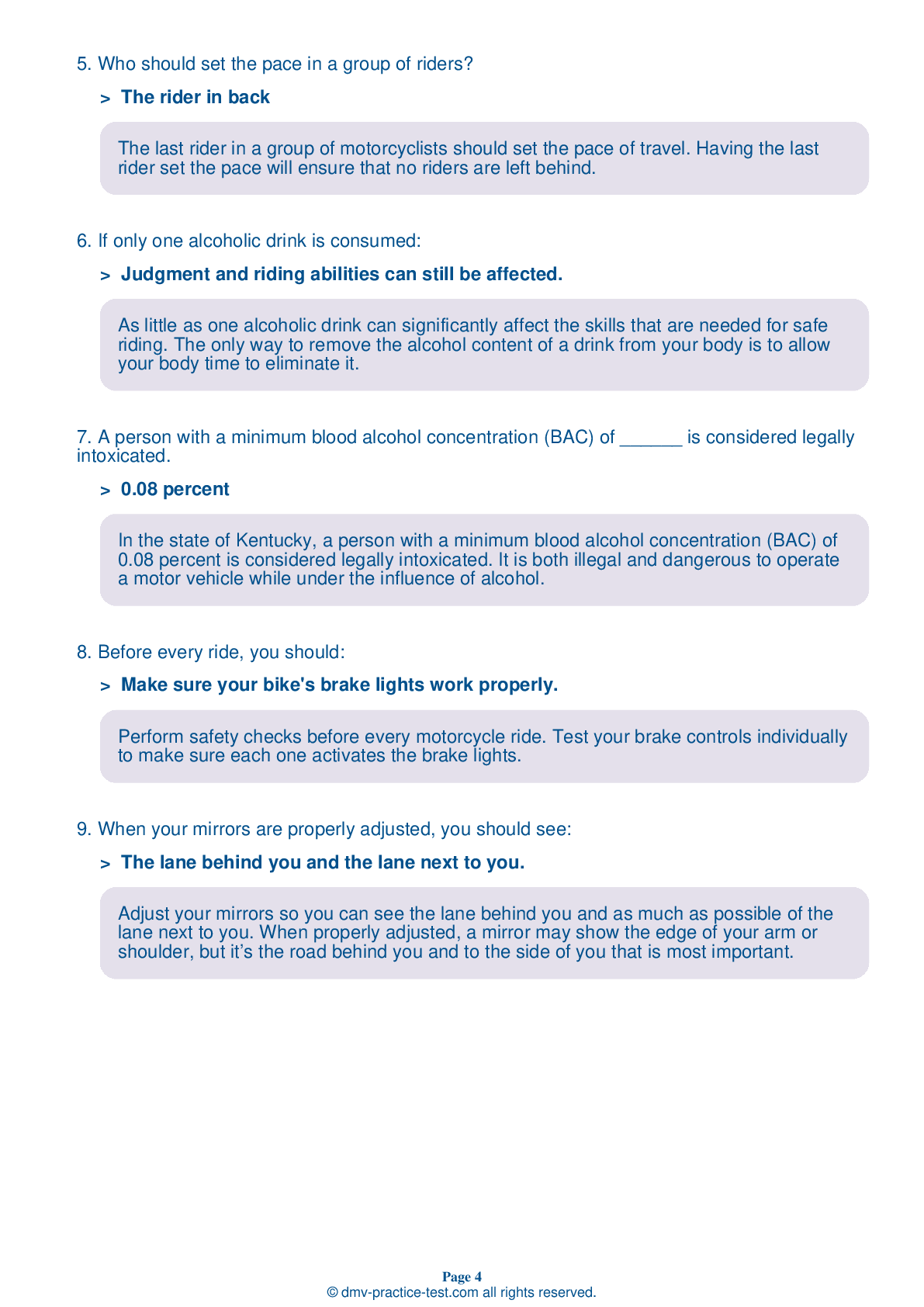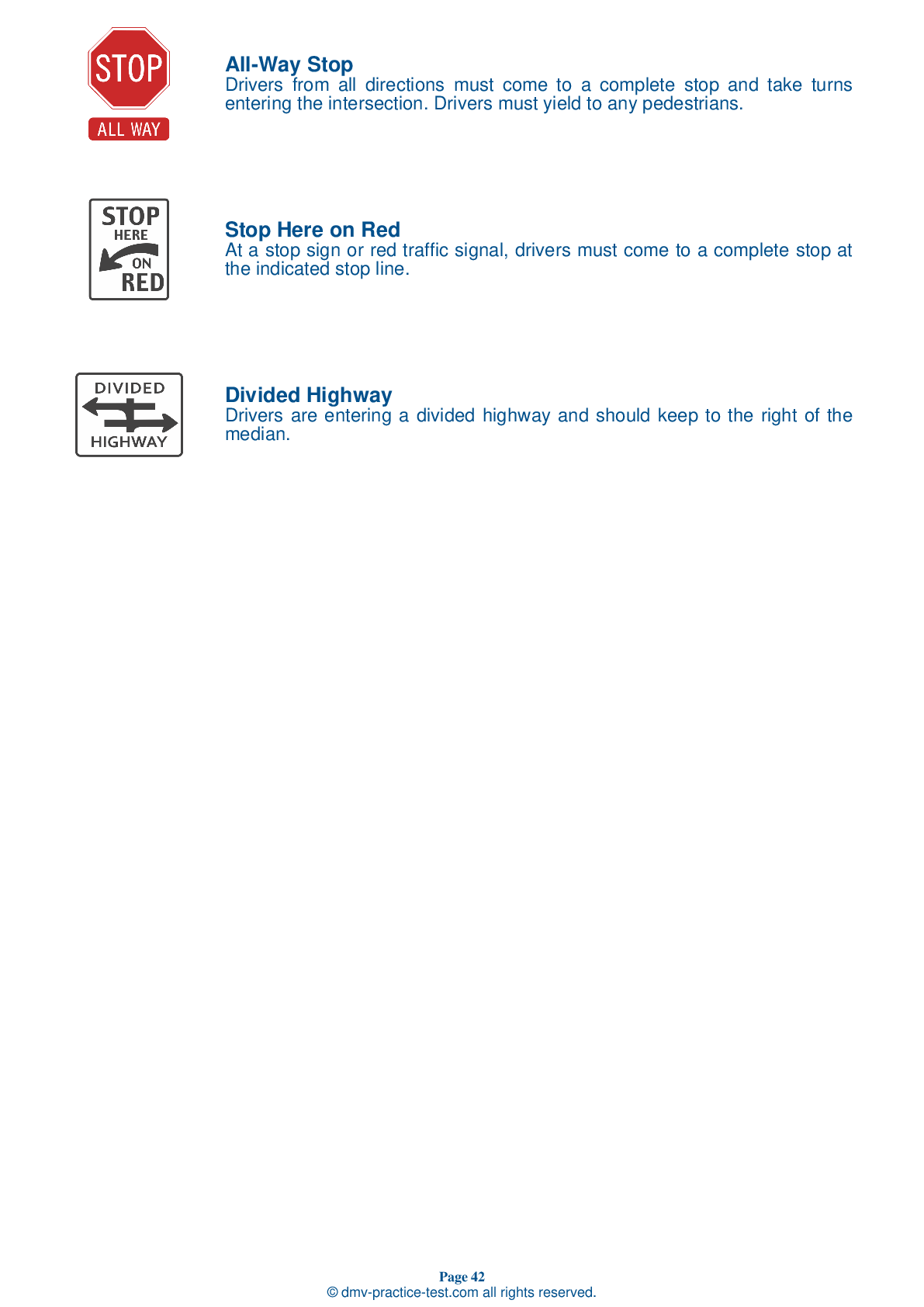DMV Permit Test #4
Motorcycle Test | License KY 2025 | FREE Online Practice! #4
Take this FREE motorcycle test (license in KY 2025) to check your knowledge of the road rules. To improve your results, download a motorcycle handbook online, study theory, and practice for free on our website. Still worried about how to get a motorcycle license in Kentucky in 2025? Check our website for more sample tests, train as much as possible, and boost your grades!
30
24
16
1 . Downward-facing triangular signs:
Tell riders to speed up.
Downward-facing triangular signs usually indicate that road users should yield. Once the road is clear of traffic, bicycles, or pedestrians and it is safe to do so, riders may proceed.
2 . This sign means:

A school zone is ahead.
Warning signs are used to warn drivers about upcoming hazardous conditions and are usually yellow with black markings. This sign tells drivers that they are approaching a school zone and that they should slow down and watch for children.
3 . How does the stopping distance for motorcycles compare to the stopping distance for cars?
Both motorcycles and cars take about the same amount of time to stop.
Under normal conditions, the stopping distances for motorcycles is nearly the same as it is for cars. However, slippery pavement makes quick stops especially difficult for motorcycle operators.
4 . When operating a motorcycle on a slippery surface, you should:
Use only the rear brake.
When riding on slippery surfaces, you should reduce your speed. Make certain to use both brakes when braking and avoid making sudden moves.
5 . This sign means:

Freeway on-ramp ahead.
Warning signs are usually diamond-shaped with black markings on a yellow background. They alert drivers to upcoming hazards. This sign warns drivers that the right lane is ending or that the road is narrowing ahead.
6 . Passengers should:
Never hold onto the operator.
Passengers should sit directly behind the operator and lean as the operator leans. They should sit as far forward as they can without crowding the operator, holding onto the operator's waist, hips, or belt.
7 . To provide the best protection to the wearer, boots or shoes should:
Have tall heels.
For riding, choose boots or heavy shoes that are tall and sturdy enough to cover and support your ankles. Heels should be low so that they won't catch on rough surfaces. Tuck in long laces so that they don't catch on the motorcycle's moving parts.
2025 Kentucky | Frequently Asked Questions
To acquire a motorcycle driver's license in Kentucky, you must first obtain a motorcycle permit by passing a written test. After holding the permit for a month, you can take the road skills test to get your license. If you're under 18, you must also complete a motorcycle safety education course. All applicants must pay the necessary fees.
In Kentucky, the minimum age for obtaining a motorcycle driver's license is 18 years. However, if you're under 18, you can get a motorcycle permit after completing a driver's education course. This permit allows you to ride under certain restrictions for practice before taking the test for the full motorcycle license.
Yes, you do need a dedicated license to legally ride a motorcycle in Kentucky. This is often called a motorcycle endorsement and is added to your regular driver's license. To obtain this, you must pass a written test and a skills test. The purpose is to ensure that you understand the unique safety issues related to motorcycle operation.
To apply for a motorcycle driver's license in Kentucky, you'll need proof of identity (like a birth certificate or passport), proof of Social Security number (like a Social Security card or W-2 form), and proof of Kentucky residency (like a utility bill or lease agreement). If you're under 18, you'll also need a parental consent form.
Yes, you will need to take a written exam to get a motorcycle license in Kentucky. The test is designed to assess your knowledge of motorcycle operation, traffic rules, and safety procedures. This is a mandatory step in the licensing process and cannot be waived, even if you've completed a motorcycle training course.
The motorcycle written test in Kentucky covers topics such as road rules, traffic signs, and motorcycle safety. It tests your knowledge on operating a motorcycle, including handling emergencies and braking techniques. You'll also be tested on specific laws related to motorcycle use in Kentucky. The Kentucky Motorcycle Operator Manual is a good resource to prepare for the test.
No, in Kentucky, the motorcycle training course does not substitute the written test. The written test is mandatory to obtain a motorcycle permit or license. However, completion of a Motorcycle Safety Education Course may waive the skills test, but the written exam is still required to ensure understanding of road rules and safety.
To enroll in a motorcycle training course in Kentucky, you need to find a state-approved school offering the course. Contact the school directly to register. They'll provide details about the course schedule, fees, and what you need to bring. Most schools require you to have a motorcycle permit before starting the course. Completing the course can sometimes help waive the road test for your license.
No, you do not have to own a motorcycle to take the license test in Kentucky. You can borrow a motorcycle as long as it is registered, insured, and meets all safety requirements. However, if the owner is not present during the test, you must provide written permission from the owner to use it.
Yes, you can use a friend's motorcycle for the driver's license evaluation in Kentucky. However, the motorcycle must be properly registered, insured, and meet all safety standards. Also, ensure you are comfortable and familiar with the bike's controls and operations to successfully pass the test.
Yes, the Kentucky motorcycle driving exam tests specific handling skills. These include the ability to control the motorcycle during low-speed maneuvers, sudden stops, and turns. It also tests your ability to change lanes safely, navigate through intersections, and maintain proper positioning on the road. You must demonstrate these skills proficiently to pass the exam.
Yes, new motorcycle drivers in Kentucky with a permit face several restrictions. They are not allowed to ride after dark, carry passengers, or ride on the interstate. These limitations are lifted once the rider passes the road test and obtains a full motorcycle license. The goal of these restrictions is to ensure new riders gain experience safely.
Yes, your Kentucky motorcycle license is valid throughout the United States. All states recognize out-of-state motorcycle licenses, so you're free to ride across state lines. However, be aware that traffic laws and helmet requirements may vary from state to state. Make sure to familiarize yourself with the rules of the road in each state you plan to ride in.
In Kentucky, motorcycle helmet laws require all riders under 21, novice riders, and those with instructional permits to wear a helmet. However, for riders over 21 who have been licensed to operate a motorcycle for more than one year, wearing a helmet is not mandatory. Nonetheless, wearing a helmet is always recommended for safety reasons.
Yes, Kentucky offers two types of motorcycle licenses. The Motorcycle Permit allows you to ride under certain restrictions, perfect for beginners. The Motorcycle License, which requires passing a road test, provides full riding privileges. There's also a Motorcycle Only License for those who don't have a regular driver's license. Each type requires passing a written test and vision screening.
Yes, in Kentucky, you can add additional endorsements to your motorcycle license. These could include endorsements for operating different types of motorcycles or for towing trailers. To obtain an endorsement, you typically need to pass both a written test and a skills test related to the specific endorsement.
Yes, the Kentucky motorcycle license test can be taken in multiple languages other than English. It's advised to contact your local DMV office to confirm the availability of the test in your preferred language. Some locations may also permit the use of translator or interpreter services during the test.
An effective strategy for preparing for the motorcycle license test in Kentucky involves studying the Kentucky Motorcycle Operator Manual thoroughly. This manual covers all the information needed for the test. Additionally, taking online practice tests can help familiarize you with the format of the exam and identify areas you need to focus on.
Yes, the Kentucky motorcycle written exam is available in several languages other than English. However, it's recommended to contact your local DMV office to verify the availability of specific languages. Additionally, some locations may offer the use of a translator or interpreter service during the test.
Yes, retaking is allowed. If you fail the motorcycle written test in Kentucky, you can retake it. However, you must wait at least one day before retesting. It's recommended to review the Kentucky Motorcycle Manual and take some practice tests before your next attempt to increase your chances of passing.



